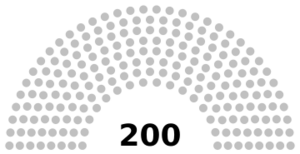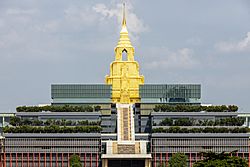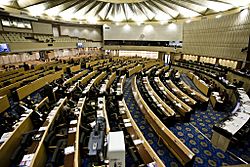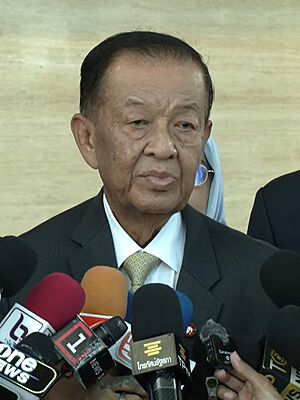National Assembly (Thailand) facts for kids
Quick facts for kids National Assemblyรัฐสภา Ratthasapha |
|
|---|---|
| 26th Parliament | |

Seal of the National Assembly
|
|
| Type | |
| Type | |
| Houses | Senate House of Representatives |
| History | |
| Founded | 28 June 1932 |
| Leadership | |
|
Vajiralongkorn
Since 13 October 2016 |
|
|
Wan Muhamad Noor Matha, Prachachart
Since 5 July 2023 |
|
|
Vice President of the National Assembly
(President of the Senate) |
Mongkol Surasajja
Since 26 July 2024 |
|
Paetongtarn Shinawatra, Pheu Thai
Since 16 August 2024 |
|
|
Leader of the Opposition
|
Natthaphong Ruengpanyawut, People's
Since 25 September 2024 |
| Structure | |
| Seats |
|
 |
|
|
Senate political groups
|
|
 |
|
|
House of Representatives political groups
|
Government (253)
|
| Elections | |
| Indirect limited voting with self-nomination | |
| Parallel voting: First-past-the-post voting (400 seats) Party-list proportional representation (100 seats) |
|
|
Senate last election
|
9–26 June 2024 |
|
House of Representatives last election
|
14 May 2023 |
|
Senate next election
|
August–September 2029 |
|
House of Representatives next election
|
On or before 28 June 2027 |
| Meeting place | |
 |
|
| Sappaya-Sapasathan Dusit, Bangkok Thailand |
|
| Website | |
| parliament.go.th | |
The National Assembly of Thailand (often called the Ratthasapha Thai) is the main law-making body of Thailand. It has two parts, like a two-story building for laws. This assembly meets in a special building called the Sappaya-Sapasathan in Bangkok.
It was first created in 1932. This happened after Thailand got its first constitution. This change meant Thailand moved from having a king with all the power to a constitutional monarchy. In this system, the king is still the head of state, but a government and assembly make the laws.
During a time of political changes in 2014, the National Assembly was temporarily replaced. A new assembly, called the National Legislative Assembly, took its place. This temporary assembly was set up by the military.
The National Assembly was brought back in 2017 with a new constitution. It fully started working again after the elections in 2019.
Contents
Understanding Thailand's National Assembly
What is the National Assembly?
The National Assembly is made of two main groups: the Senate and the House of Representatives. Together, they have 700 members.
Most members, 500 of them, are in the House of Representatives. They are chosen directly by people voting in elections. The other 200 members are in the Senate. They are chosen in a different way, from a list of candidates.
Currently, about 19.4% of the members in Thailand's parliament are women. This is a bit less than the average for parliaments in Asia and around the world.
The Senate: Thailand's Upper House
The Senate is like the "upper house" of the National Assembly. It has 200 members. These members are chosen indirectly from different professional and social groups.
Senators serve for five years. They are not supposed to belong to any political parties. They also cannot hold other government jobs while they are senators. The Senate has limited powers to make laws.
The House of Representatives: Thailand's Lower House
The House of Representatives is the "lower house." It has 500 members. 400 members are elected directly by voters in different areas. The other 100 members are chosen based on how many votes their political party gets across the country. This system is called "parallel voting."
When people vote in a general election, they usually get two votes. One vote is for a person to represent their local area. The second vote is for a political party they like.
Members of the House serve for four years. However, the House can be dissolved earlier, meaning new elections might happen sooner.
How People Vote: Elections in Thailand
In Thailand, most adults can vote. To vote, you must be a Thai citizen. You also need to be over 18 years old in the year the election happens. You must register to vote at least 90 days before the election.
Some people cannot vote in House elections. These include religious leaders, people who have lost their voting rights for legal reasons, and those with certain mental health conditions. Voting in Thailand is required for eligible citizens.
Who Leads the Assembly?
The person in charge of the entire National Assembly is called the President of the National Assembly of Thailand. This job is automatically given to the person who is chosen as the Speaker of the House of Representatives.
The Vice President of the National Assembly is the person who is chosen as the President of the Senate. These leaders help guide the work of the assembly.
What Does the Assembly Do?
The National Assembly has important jobs. Its main job is to create and approve laws for Thailand.
How New Laws Are Made
Here is how a new law is usually made:
- A new law idea, called a bill, can be suggested by several groups. These include the government's Cabinet, at least twenty members of the House of Representatives, courts, or special independent government groups.
- Also, if at least ten thousand voters sign a petition, they can suggest a new law.
- If a bill involves money, only the Prime Minister can approve its introduction.
- The House of Representatives first discusses, changes, and votes on the bill. If they approve it, the bill goes to the Senate.
- The Senate then has 60 days to review the bill. If it's a money bill, they have 30 days.
- If the Senate agrees with the House, the bill moves forward. If they disagree or make changes, the bill goes back to the House.
- If the House and Senate still can't agree, they form a special committee. This committee has members from both houses. They work together to find a solution.
- Once both houses agree on the bill, the Prime Minister sends it to the King. The King then gives his official approval, called "royal assent."
- After the King approves it, the new law is published in the Royal Gazette. Then it officially becomes a law.
- If the King does not approve the bill, the National Assembly can vote on it again. If at least two-thirds of all members vote to approve it, the Prime Minister can still publish it as a law. This means the assembly can override the King's decision.
Working with the Government
The government of Thailand, especially the Cabinet (which includes the Prime Minister and other ministers), works closely with the National Assembly. The Cabinet must tell the National Assembly its plans and policies soon after taking office. The National Assembly can ask any minister to come and explain their work or answer questions. This helps the assembly keep an eye on the government. Some ministers might not be members of the National Assembly. But if they are, they can only be from the House of Representatives. Senators are not allowed to be part of the Cabinet. The Prime Minister is chosen by the House of Representatives. This means the Prime Minister is directly responsible to the assembly. The assembly can ask the Prime Minister to explain policies and answer questions. The Cabinet can also ask the National Assembly to meet for special, urgent sessions.
Appointing and Removing Officials
The National Assembly also has the power to choose and remove important officials. The House of Representatives has the special job of electing the Prime Minister. A candidate needs support from many members and then a majority vote to be chosen. The King then officially appoints the Prime Minister. The Senate helps choose members of the court system and leaders of independent government groups. These include judges for the Constitutional Court and members of the Election Commission. The National Assembly can also remove these officials from their jobs if they do not perform well. The Prime Minister can be removed by a special vote in the House of Representatives. Other ministers can be removed by a vote in either house.
How Long Do Members Serve?
The two parts of the National Assembly, the Senate and the House, serve for different lengths of time. Senators serve for five years. Members of the House of Representatives serve for four years. The National Assembly usually has two meetings each year. These are called an "ordinary" session and a "legislative" session. The first meeting of the National Assembly after an election must happen within 30 days. The King officially opens this first meeting with a special speech. This ceremony takes place in the Ananda Samakhom Throne Hall. The King also has the power to end sessions or call for extra meetings if needed.
Sometimes, both the Senate and the House meet together in a "joint-sitting." This happens for important matters. For example, they meet together to approve a declaration of war or to change the constitution.
Special Rules for Members
Members of the National Assembly have special protections while they are doing their work. These are called "parliamentary privileges." For example, they cannot be arrested or held for questioning in a criminal case during a session. This is unless their house gives permission or they are caught doing something illegal at that moment. Both houses also get to decide their own rules and how they will work. This includes how they form committees, hold meetings, and vote on laws.
The Assembly's Meeting Places
From 1932 to 1974, the National Assembly met in the Ananda Samakhom Throne Hall. This was a beautiful old building. But as the number of members grew, it became too small.
A new Parliament House was built and first used in 1974. King Bhumibol Adulyadej helped by providing land for the new building. This complex had three buildings:
- The main Parliament House building had the meeting room for both the Senate and the House. It also had offices for the leaders.
- A second building held the offices for staff and a printing press.
- A third building was a club for members, with facilities for them.
The Ananda Samakhom Throne Hall then became a historic building. It was returned to the King. Only the special opening ceremony for new sessions is still held there.
In 2013, the National Assembly decided to move to an even newer and bigger building. This new building is called Sappaya-Sapasathan. It officially opened on May 1, 2021. It is now the main meeting place for the National Assembly.
A Look Back: History of the Assembly
From Absolute Rule to People's Voice
Before 1932, the King of Thailand (then called Siam) made all the laws. There was no assembly to help. But on June 24, 1932, a group called the Khana Ratsadon (People's Party) made a big change. They led a peaceful revolution. This ended the King's absolute rule. They wanted Thailand to become a constitutional monarchy. This meant the King would still be head of state, but an elected assembly would make laws.
The first assembly, called the People's Assembly, met on June 28, 1932. It had 70 appointed members. Later, in December 1932, a new constitution was made. It set up elections for November 15, 1933. This new assembly had 78 elected members and 78 appointed members.
Periods of Change and New Constitutions
After World War II, in 1946, Thailand got a new constitution. This one was very democratic. It created a two-part assembly for the first time: a Senate and a House of Representatives. Both parts were elected, which was unique. The Senate served for six years, and the House for four years.
However, there were many changes in Thailand's government structure over the years. Sometimes, the military played a big role in these changes. For example, in 1947, the constitution was changed. The new Senate had 100 members chosen by the King. Later, there were times when the National Assembly was replaced by a single, appointed assembly. Sometimes, the assembly was even abolished for a short period. In 1969, the National Assembly returned with an elected House and a Senate appointed by the King. But this also changed again. In 1973, after a period of unrest, a new constitution brought back a two-part assembly. It had an elected House and a Senate chosen by the House. By 1978, the government structure changed again. It had an elected House and a Senate appointed by the Prime Minister.
The Assembly in Modern Thailand
The Constitution of 1997 brought back a strong democratic system. It created a National Assembly with a 500-member elected House and a 200-member elected Senate. This system worked for about ten years.
After some political events in 2006, this constitution was replaced. A new constitution was approved in 2007. Then, after more political changes in 2013, the country was governed by a temporary constitution. Finally, a new constitution was approved in a vote in 2016. It was officially endorsed by King Vajiralongkorn on April 6, 2017. This constitution re-established the National Assembly as it is today.
Meet the Current Leaders
| The Senate | The House of Representative | ||||
|---|---|---|---|---|---|
| The President
Mongkol Surasajja |
The Speaker Wan Muhamad Noor Matha | The Prime Minister | The Leader of the Opposition
Natthaphong Ruengpanyawut |
||
| 1st Vice-President
Kriangkrai Srirak |
2nd Vice-President
Bunsong Noisophon |
1st Deputy-Speaker
Phichet ChuaMuangPan |
2nd Deputy-Speaker
Pharadorn Pritsananantakul |
Deputy Prime Ministers
|
|
See also
 In Spanish: Asamblea Nacional de Tailandia para niños
In Spanish: Asamblea Nacional de Tailandia para niños
- President of the National Assembly of Thailand
- Government of Thailand
- Politics of Thailand
- Constitution of Thailand
- Senate of Thailand
- House of Representatives of Thailand
- Elections in Thailand




